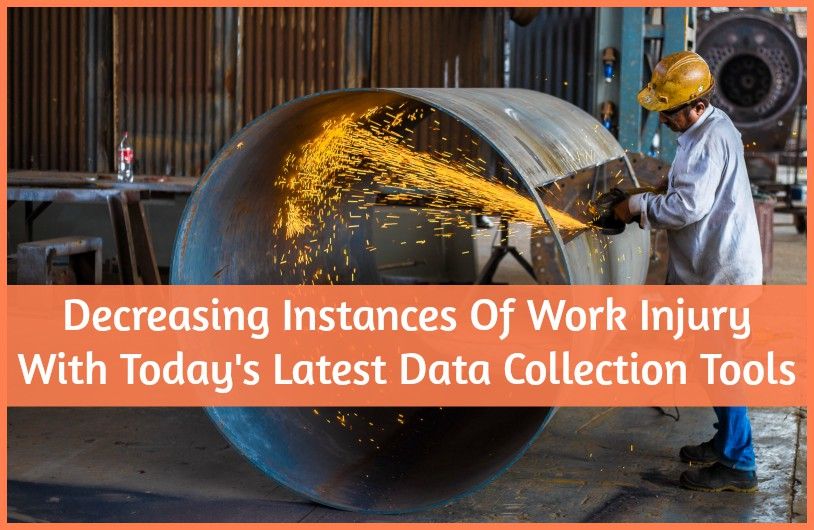
Decreasing Instances Of Work Injury With Today’s Latest Data Collection Tools
Data collection tools provide a viable way to reduce paperwork. By using these tools to collect and store pertinent safety-related data, it becomes possible to minimize the likelihood of your workers experiencing a work injury. Not only do the tools reduce HR workloads, but when utilized correctly, they provide a clear picture of how safe your workplace is.
Safety professionals have the responsibility of collecting and analyzing massive amounts of data. They typically investigate incidents, monitor OSHA compliance, and create policies that can reduce workplace injuries.
Let’s take a close look at how data collection tools can minimize workloads and lead to a safer work environment.
When safety professionals audit your workplace, these tools will prove to be of the utmost value.
Staying Compliant with OSHA Data Collection Rules
To be compliant with OSHA data collection rules, you must keep a detailed record of any work-related injury; this applies whether the injury was sustained on or off the work premises. If it relates to any aspect of your business, it must be recorded. In addition, work-related illnesses must be documented. There are various logs that must be used when recording this data.
The OSHA 300 is an ongoing log that outlines all work-related injuries and illnesses.
Within the log, you should provide details to each incident, including how it happened, how many days of work were lost by the employee, and whether or not any work restrictions were placed on the worker. You’ll also want to categorize the injuries and illnesses to help you see which incidences are the most prevalent.
The OSHA 300A is a detailed summary of the OSHA 300.
 You will tally up all work-related injuries and pinpoint how many of each type of injury or illness there were. You’ll also get a clear overview of how many days in total were lost in regards to employees not being able to work because of the injury or illness. The OSHA 301 provides an overview of each incident. Even minor instances of injury and illness are recorded in the OSHA 301.
You will tally up all work-related injuries and pinpoint how many of each type of injury or illness there were. You’ll also get a clear overview of how many days in total were lost in regards to employees not being able to work because of the injury or illness. The OSHA 301 provides an overview of each incident. Even minor instances of injury and illness are recorded in the OSHA 301.
Riskonnect can be used to simplify incident recording. Pre-built templates can be used to record the incidents, and from there, you can print the paperwork and store it in your OSHA logs.
- You can also use the tool to keep track of all safety-related training that your employees have gone through.
- You can have your employees go through endless hours of training, but if you don’t record it hour for hour, you will not uphold compliance.
With data collection tools, you are provided with an easy-to-access, centralized location for storing all training information.
Minimizing the Headaches of Audits
No one likes audits.
They are often time-consuming and stressful. Detailed paperwork is essential to making sure you are able to pass an audit. More importantly, it can help prevent workplace injury by showing you where improvements need to be made. BambooHR (among many other HR Software suppliers) is a tool that is particularly beneficial for ensuring optimal HR data governance and is excellent for taking the headache out of audits.
When asked to present certain documentation, you can easily access it using advanced search capabilities.
Optimal View of Work Orders
Work injuries are more likely to take place when everyone isn’t on the same page. Capterra provides you with a bird’s eye view of work orders in real time. This type of access ensures everyone is being held accountable. If there is an issue, you can immediately pinpoint who is responsible and what actions need to be taken. Having this tool in place will motivate employees to be extra careful and to complete their work orders on time.
Benefits of Using Data Collection Tools for Safety Reasons
Integrating data collection tools into all of your operations will allow you to see which injuries are the most common. The automation aspect of the tools saves time and energy, allowing your teams to be more productive. You’ll be able to see where workflows are hindered followed by performing improvements that are centered around increasing productivity while also maintaining a safe working environment.
These tools also enable you to determine the root causes of injuries and illnesses. While you may be tempted to categorize injuries and illnesses a certain way, the analysis capabilities of the tools will make it easier to categorize the incidents more appropriately. By understanding the true root cause of the issues, you will find it easier to create solutions that reduce workplace injuries.
Another notable benefit of the tools is that they allow you to spot accident-prone groups.
For example: You may find that a certain workstation is experiencing the most injuries. If this is the case, then you know to shut down that workstation until a proper remedy can be applied. By narrowing your focus on the groups that are most prone to accidents, you can better allocate your resources and time.
The goal is to create a safe work environment where injuries and illnesses are kept to an absolute minimum. Tools like Zoho and Zenefits make this goal realistic. Your data collection process will be more accurate because there is less room for human error when data is collected, stored, and analyzed in an automated manner. Your data will be exactly where it should be, providing easy access.
Not only do data collection tools make your job more efficient, but they also create a work culture that is centered around safety.
© New To HR (we have no affiliation with the HR & Analytics tools shared above)


